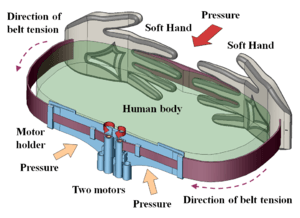UT Dallas researchers are extending the borders of virtual reality, going beyond virtual spaces in which people can see and hear each other to an environment that adds the sense of touch.
The technology would make it possible for physical therapists, for example, to work with patients in other locations. When a patient pushes down on a device, a doctor’s device in another location would also move down with the same force, as if the patient were physically pressing the doctor’s hand.
Professors in the Erik Jonsson School of Engineering and Computer Science are creating a multimedia system that uses multiple 3-D cameras to create avatars of humans in two different places, and then puts them in the same virtual space where they can interact.
In traditional telemedicine, a doctor and patient both appear on the same screen and are able to talk, but they are not in the same physical space.
“With in-home rehabilitation, doctors ask a patient if he or she has done their exercises, but the patient may not be doing them correctly,” said Dr. Balakrishnan “Prabha” Prabhakaran, professor of computer science at UT Dallas and a principal investigator of a $2.4 million project funded by the National Science Foundation to create the system.
“It is one thing for a patient to say he or she did their exercises, but it is another to watch them in action, feel the force exerted, be able to correct them on the spot and get immediate response.”
With large amounts of data, such as tracking images or movement, there could be significant lag time or delays in transmission. The grant funds creation of the algorithms and software needed to transmit the data through the internet in real time. There are four major areas of this system under research by experts in the Jonsson School.
Haptic Devices
Haptic devices are pieces of equipment with resistance motors that apply force, vibration or motion to the user to provide feedback. For example, touching a virtual stone with a haptic device would feel hard, while touching a virtual sponge would provide less feedback and feel more pliable.
If both doctor and patient have haptic devices in his or her physical environment, the applied force can be sent to the other person. A doctor could feel the strength of a patient’s muscle, for example.
“Each device sends lots of data and combining that information in real time is a big challenge,” Prabhakaran said.
Prabhakaran has expertise in multimedia systems and using haptic devices in real time.
Teleoperation and Control
Anyone who has used a service such as Skype has likely experienced a delay in communication – suddenly words get lost or are slow to transmit. A similar effect could happen with haptic devices.
“We absolutely do not want instability,” Prabhakaran said.
Dr. Mark W. Spong, dean of the Jonsson School and holder of the Lars Magnus Ericsson Chair in Electrical Engineering and the Excellence in Education Chair, is a leading researcher in control and teleoperation – operating of machines at a distance. He is developing techniques to eliminate instability in communicating the data from the haptic devices over the network.
via University of Texas, Dallas
The Latest Streaming News: Virtual Reality updated minute-by-minute
Bookmark this page and come back often
Latest NEWS
Latest VIDEO








